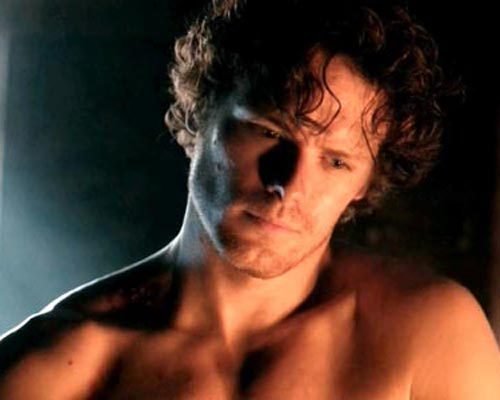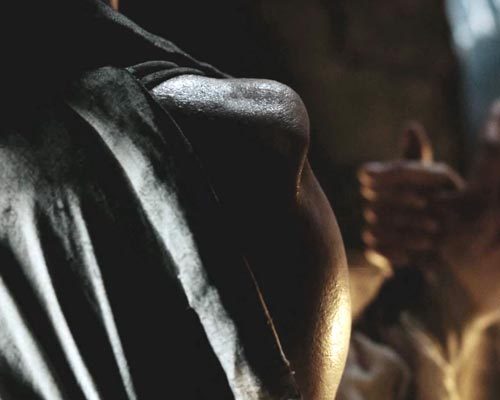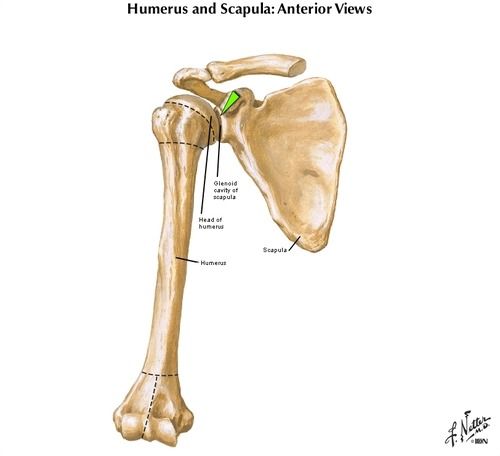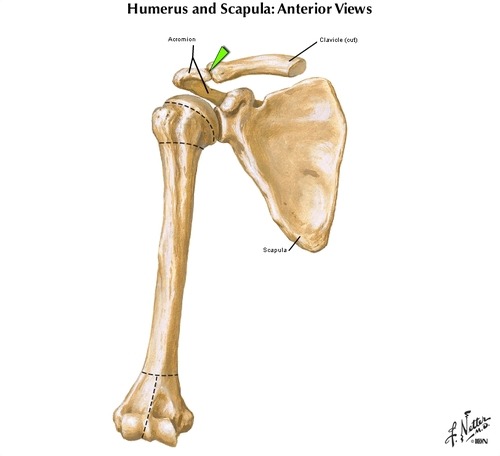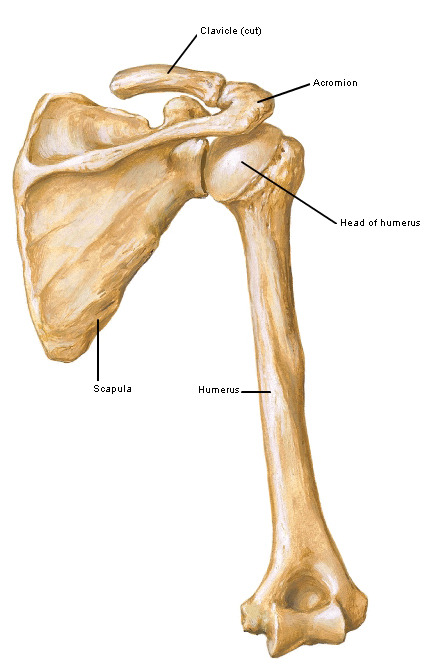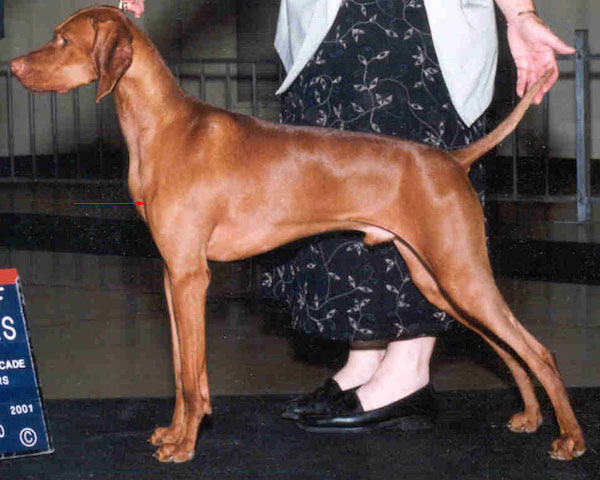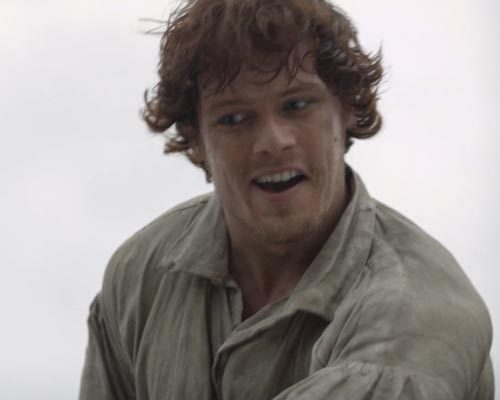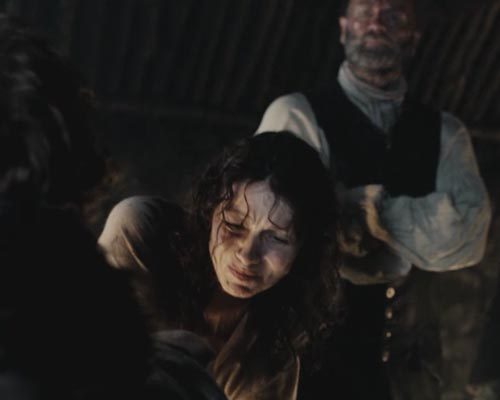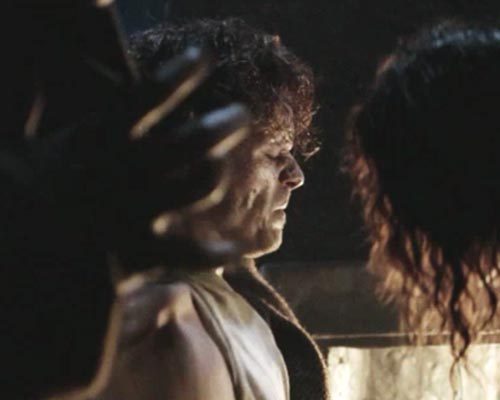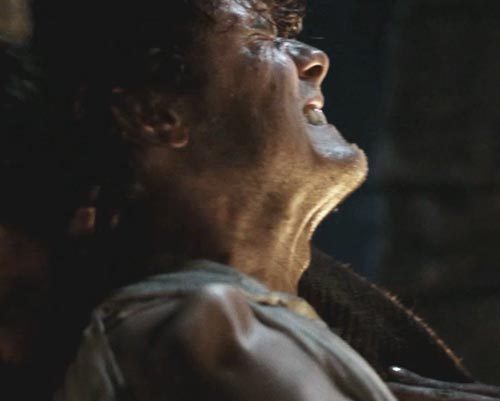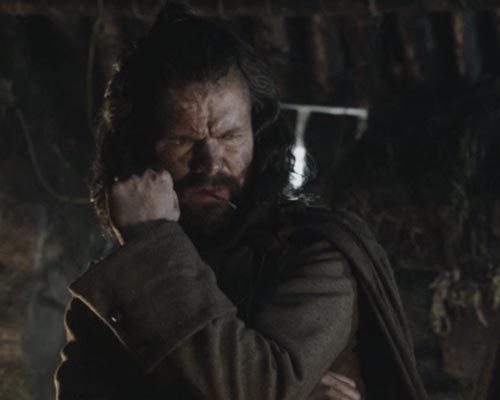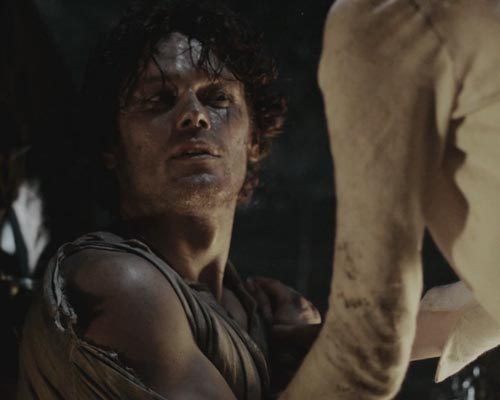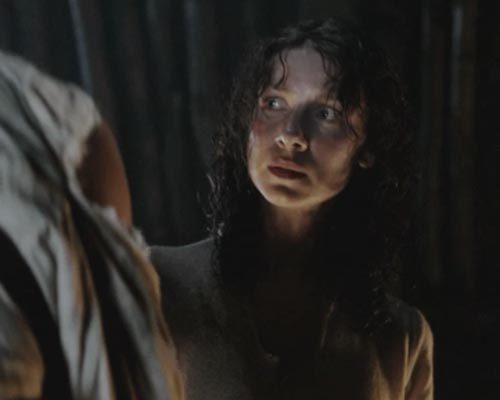Greetings friends of Outlander Anatomy and welcome to today’s lesson! Do you recognize the classic seven wonders of the world?
- Colossus of Rhodes.
- Great Pyramid of Giza.
- Hanging Gardens of Babylon.
- Lighthouse of Alexandria.
- Mausoleum at Halicarnassus.
- Statue of Zeus at Olympia.
- Temple of Artemis at Ephesus.
The 8th wonder is, of course, James Fraser’s chest!
Getting in a mood, let’s take a wee keek at the breadth (Uncle Dougal, ye are a crud for exposing your nephew like this!)…
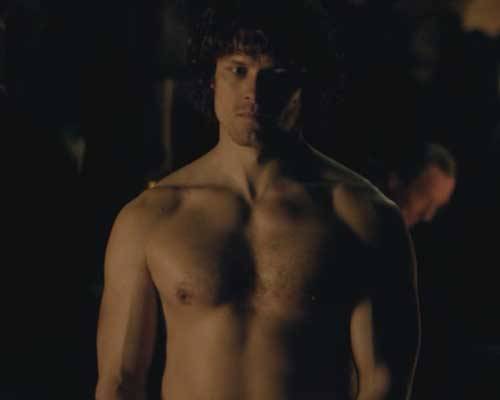
And the depth (BJR, man, ye are darkness itself!):
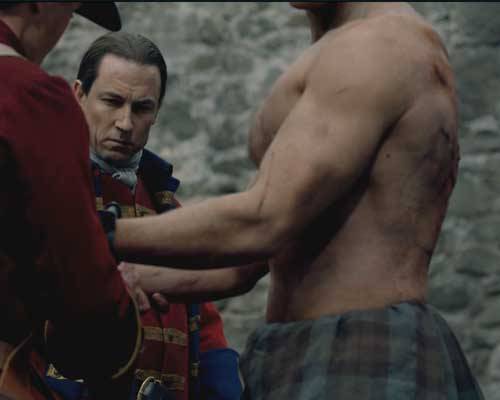
Of this very timely topic!
Now, we all ken that Claire gets her first TV looksee at Jamie’s blest-chest in Starz episode 102, Castle Leoch. But, Herself wrote in Outlander that Claire made touchdown with his chest when he fainted from blood loss after Cocknammon Rock:
“Stop! Help!” I yelled. “He’s going over!” … Jamie slid off headfirst like a sack of stones, luckily landing in someone’s arms. The rest of the men were off their horses and had him laid in a field by the time I had scrambled down. “He’s breathin’,” said one.
“Well, how very helpful,” I snapped, groping frantically for a pulse in the blackness… Putting a hand on his chest and an ear to his mouth, I could feel a regular rise and fall, with less of that gasping note. I straightened up. “I think he’s just fainted,” I said.
He groaned and opened his eyes… “I’m all right,” he said, trying to sit up. “Just a bit dizzy is all.” I put a hand on his chest and pushed him flat.
The instant the bandages were tied, the patient tried to sit up. I pushed him flat and put a knee on his chest to keep him there. “You are not to move,” I said fiercely.
So, leading up to Nurse Claire actually seeing his chest, let’s start with the castle courtyard. I have to begin the lesson here because I LOVE the courtyard scene with all its swirling undercurrents!
After dismounting, our bedraggled Claire stands there saying nothing but watching everything.

Puir lass, the front of her slip and dress have gone bye-bye, having given those up for Jamie’s field dressing. Left in her ruined, oxford walking shoes and hair in straggles, she stands out like a wee sore thumb! She is scairt and confused but tough as nails.
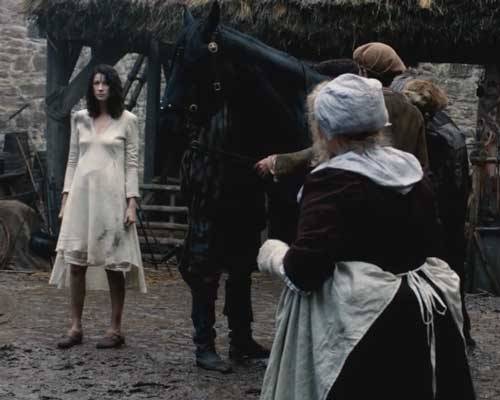
Our stalwart heroine stands completely IMMERSED in a maelstrom of male testosterone and ribald jokes. And, Jamie hovering…

…hovering I say!
Next, we witness a fabulous tete-a-tete between Claire, Mrs. Fitz, and Jamie where a lot is said, but a whole lot more remains unsaid!

Jamie says Murtagh found her and Dougal said to bring her along. But, it’s NO HIS FAULT that Ms. Fitz has another mouth to feed, bed to make, and body to clothe. Tcha! Just like a man!
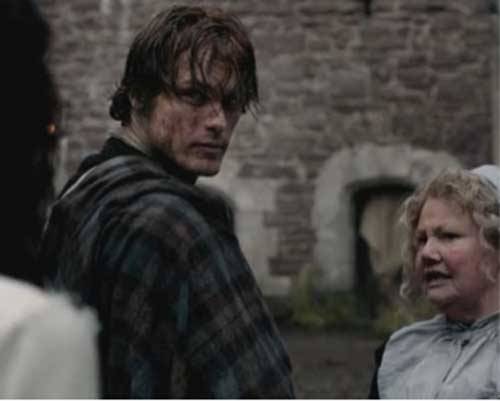
Mrs. F is shocked at Claire’s scandalous appearance and doesn’t mind saying so!
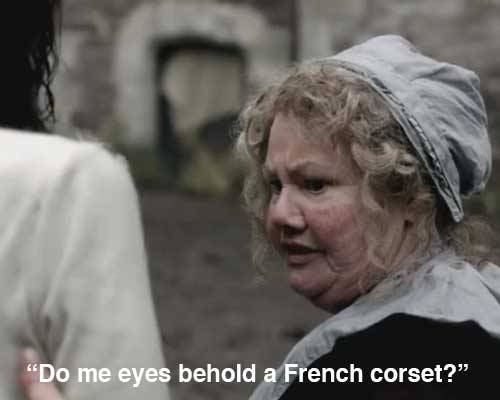
And, Jamie still hovering in the background finding any inane thing to do with his horsey, even though there are several hostlers to do the work, all the while listening and watching the two lasses size each other up.
As Grand Dame, readies to drag Claire away for cleaning up, Claire is adamant that she must properly care for Jamie’s wound as Jamie brawly boasts “I can fend fer meself!”
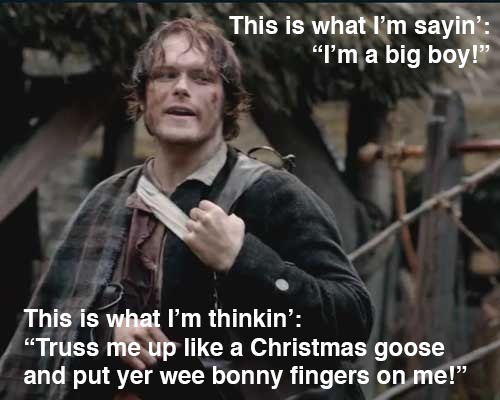
Mrs. Fitz upon hearing Claire’s credentials, declares “Jamie, ye need fixin’, git yerself indoors!” Ye heard the leddy, Jamie!
And just like that, Jamie finds himself seated on a stool covered with a blanket and ALONE with Mistress Beauchamp. (Being a wee bit nosey here, who washed Jamie’s face? Whoever it was, thanks – he cleans up nicely!). Claire gently removes the blanket to cleanse the wound and hears the awful truth that her hubby’s sixth, great grandfather gleefully produced the horrific scars on Jamie’s back.

Claire takes time to properly clean Jamie’s gunshot and apply an ingenious dressing involving a pressure bandage and strips of linen crossed under both oxters, an excellent technique for anchoring a shoulder dressing. Jamie tries moving the injured shoulder and winces, so Claire promptly straps his arm to his chest by the golden glow of firelight. Why? Claire knows the arm must immobilized for at least a week to promote wound healing, a truly complicated process! By next day, someone has replaced the strap with a sling, which is not the same at all!
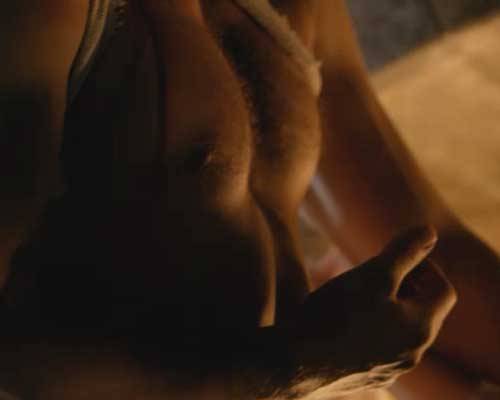
Sadly, we must leave this tender scene to start Anatomy Lesson #4. Sniff!
Terms: Let’s come to terms with it, anatomists do not use the terms upper and lower arms. Instead, the entire upper appendage is called the upper limb. The region between shoulder and elbow joints is the arm and the region between elbow and wrist joints is the forearm (Image A). This is important to know for this lesson.
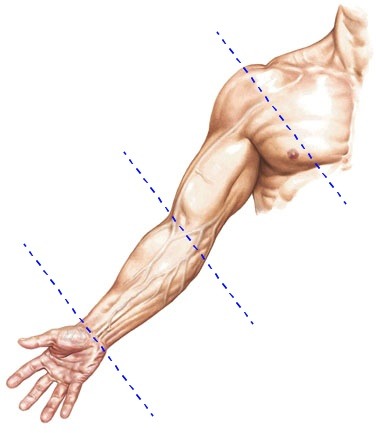
Image A
Rib Cage: The bony foundation of the chest is the thoracic (rib) cage, including 12 pairs of ribs, their costal cartilages (blue structures), sternum (breast bone) and 12 thoracic vertebrae (Image B). This spring, bony enclosure not only protects heart, lungs, airways, esophagus, and great blood vessels, it also provides attachments for important chest muscles! Above the thoracic cage lies the clavicle (collar bone) which articulates (forms a joint) with it.
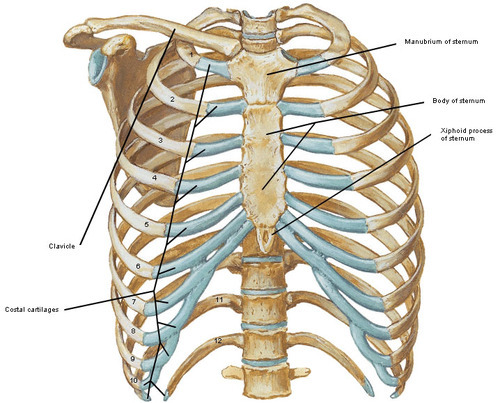
Image B
Pectoralis Major: The chest muscles or “pecs” as trainers call them, actually include two pairs of muscles on each side of the chest. The word pectoralis derives from the Latin pectus meaning “breast.”
Pectoralis major muscles are the largest, most superficial, and most powerful of the two pairs. Each fan-shaped pec major covers half of the chest and is divided into three heads. The clavicular head (Image C) arises from the clavicle.
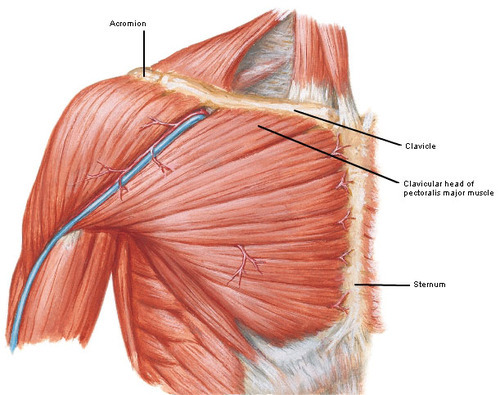
Image C
The larger sternocostal head arises from 1 through 6 costal cartilages and sternum (Image D).
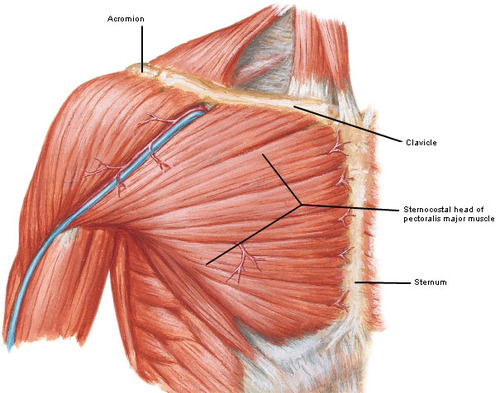
Image D
A smallish, third part (Image E) arises from an abdominal muscle. This is a fairly insignificant part unless torn in which case, the pain surpasses all conscious thought. Just kidding, except it does hurt!
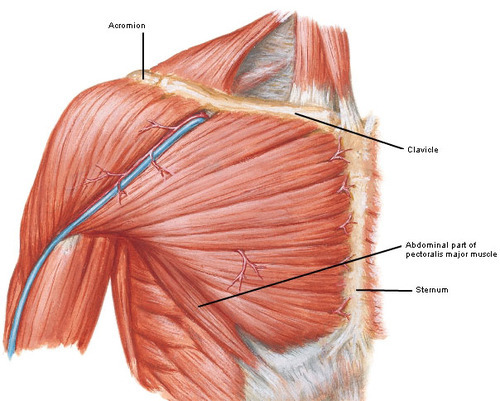
Image E
Pectoralis major muscle fibers converge toward the arm inserting into the humerus or arm bone (Image F).
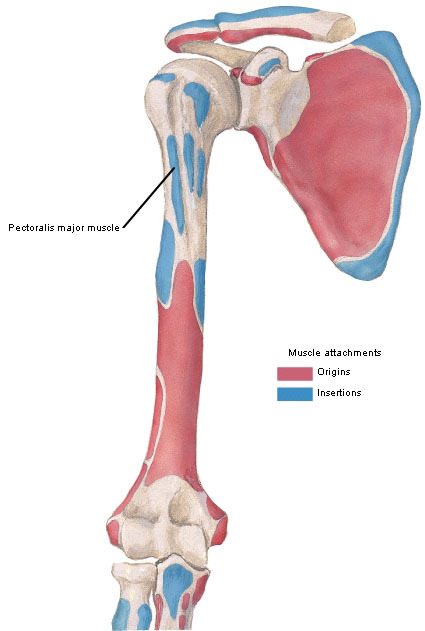
Image F
Heh! Wake up, fledgling anatomists!
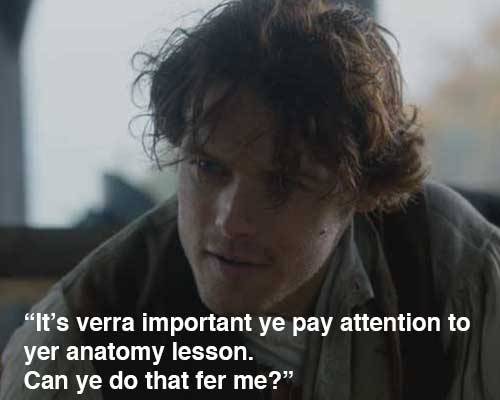
Yep, we can do pretty much anything for the Great Scot!
On their way to the humerus, pec muscle fibers create the anterior axillary fold (Image G). This fold forms the front border of the arm pit, oxter, or axilla! (I still want to see Claire stick her foot in Jamie’s oxter!) Grab this fold on a pal or sibling and give it a wee pinch. Gives them a jolt, so not a fab idea to try someone without a sense of humor!
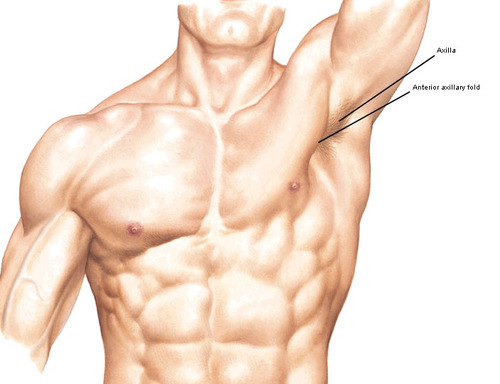
Image G
In this horrifying image from Starz episode 6, The Garrison Commander, Jamie’s massive right anterior axillary fold is very easy to spot. Our darling hero near freezes to death as BJR parades, preens, and prepares for his fav outdoor sport!
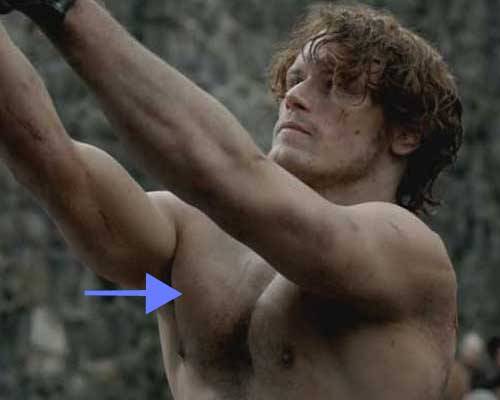
Function: Each pec major is a very hard working muscle. And, because it has three heads, they do quite a bit of work!
- raises arm forward (as in lifting a child)
- returns arm against the torso (as in setting down the child)
- pulls arm from spread eagle to the sides of torso (as in standing in mountain pose)
- rotates arm (internally) toward the chest
And, for those who wonder, pec major is best developed by standard pushups (not triceps type!), bench presses and weighted flyes.
Try This: You can see the tendons of your own pec majors this way: place palms together about 6” in front of your chest as in prayer mode. Now, press the palms firmly together. Your own pec majors should stand out strongly as the anterior axillary folds. Just don’t get them pinched!
Pectoralis Minor: In anatomy (like baseball), if there is a major – there is a minor. So, deep to each pectoralis major is a pectoralis minor muscle (Image H). This smaller fan-shaped muscle is also very important. It arises from the ribs (2, 3 & 4) and inserts on a small bony knob of the should blade known as the coracoid process (Greek for “like a raven’s beak”). Its contraction pulls forward on the corcoid process aiding in shoulder mobility and stability.
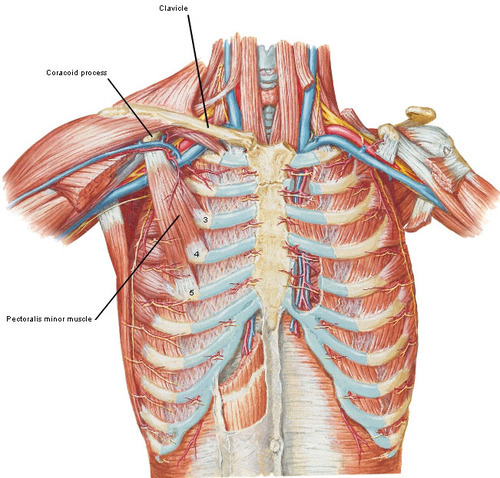
Image H
Applied Anatomy: OK, with the thoracic cage and two pairs of pecs done, let’s find them on our wonderful warrior! After Claire trusses Jamie up, the only parts of his chest still showing are the verra fine sternocostal heads of his pec major muscles, covered with skin, of course (blue arrows). Ye can see them fair keeking out from under the dressing. Awesome sauce! And, good reason to consider them the 8th wonder of the world.
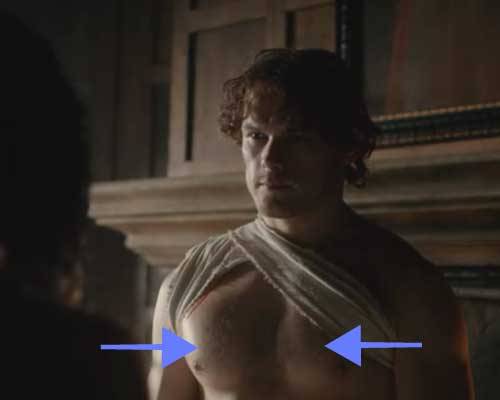
But, wait, here’s more! The clavicular heads of Jamie’s pec major muscles are unusually well developed! Check out this image (Starz episode 5, Rent) for prominent bulges just under those bonny clavicles (blue arrows). These are the clavicular heads of each pec major, an oft neglected part in body building – but not here! Props to the trainer! Gasp! They’re bloody awesome!
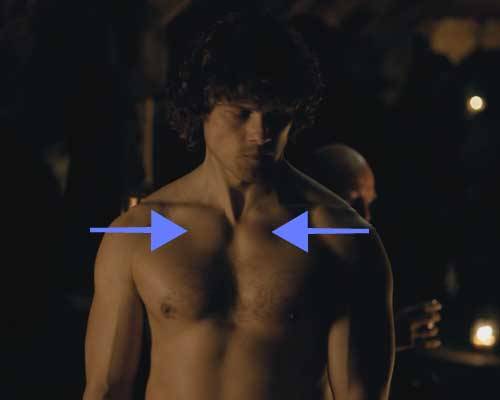
Finally, Claire has done all she can legally do for Jamie – he stands there with his glorious chest peeking through the bandages and his nipped waist and.. GAH! Lord, gimme a dram!

Now, returning to anatomy (I am a professional after all)… about 1 in about 50,000 people are born without some or all of pec major and minor muscles. Known as Poland Syndrome, it may include hand and finger anomalies and shortened forearm bones. Interestingly, people with the syndrome compensate quite well using other arm and shoulder muscles. In fact, there’s a well-known PGA player, an Olympic boxer, and a Formula 1 World Champion (car racing) that have Poland syndrome and, clearly, it didn’t hinder them! The lady shown below (Image I), from a theatrical production, has it; she is missing the sternocostal head of pec major (blue arrow).
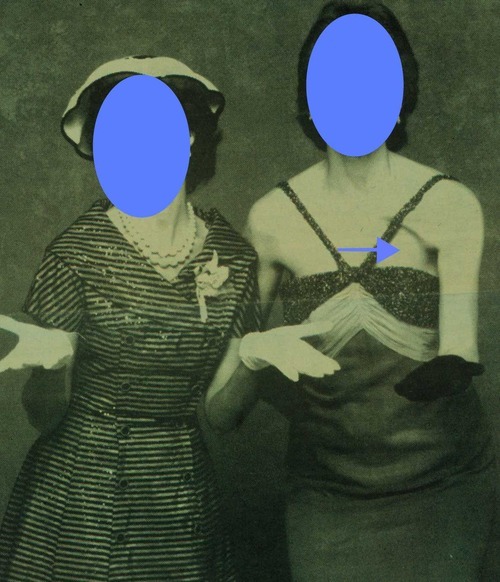
Image I
That’s it! Let’s close this lesson with a lovely poem nicely expressing the growing attraction between Nurse and Highlander!
Place your hand upon my chest.
It reminds me how it feels when it’s mended.
Then use it to cradle your head while you rest.
The worst of it, like the day, has ended.
I hope this lesson helps you more fully appreciate the chest muscles and their bony attachments. Fare thee well for now. Am thinking that Claire might be the subject of my next posting! We have ignored our amazing heroine for far too long!
How many days left before Starz episode 9? 156 days or so but who’s counting?! Sigh.
The deeply grateful,
Outlander Anatomist
Photo credits:
All photos are credited to Starz or Frank Netter’s Atlas of Human Anatomy, 4th edition. The lady with Poland’s syndrome is an archival photo from my lectures and I do not know the photographer.

